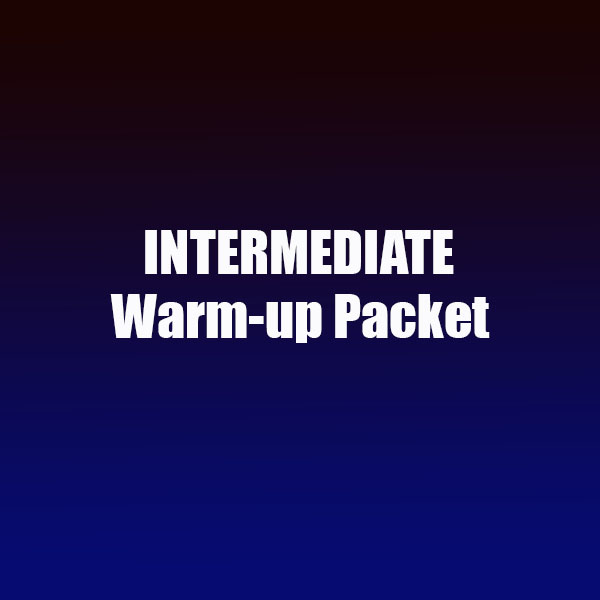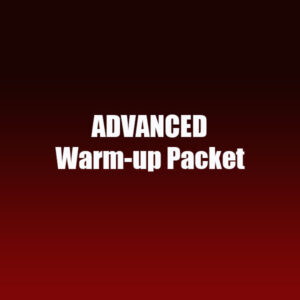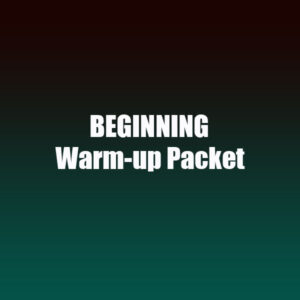Description
1. U 8 My 8s (int)
This is a “stretch out the wrists” exercise consisting of patterns of 8 measures of 8th notes, that is usually played at the beginning of a warm up session.
Pit – This is a 2-mallet octave warm up that utilizes the diatonic major scale, changing notes on the half note, then the quarter note, then the 8th note. It should be used to stretch out the wrists and establish technique and listening at the beginning of a rehearsal. The accessory part is written on a conga drum, but can be played on a tom-tom, timbale, or even a drum pad.
Battery – This is a basic “8-on-a-hand” exercise that features a “8-8-7-7-6-6-5-5-4-4-3-2” sticking pattern for the snares and tenors, starting with both the right and left hands. It then reverts to a “1-3-4-4-5-5-6-6-7-7-8-8” sticking pattern, also starting with both hands. The bass drum part begins switching drums on the half note, then quarter note, then 8th note, adding in 16th notes and 16th note triplets at the end. The cymbal part is written as “hi-hats”, but could be played with a variety of different sound techniques.
2. Vanilla Shake (int)
This is a basic “4’s, 3’s & 2’s” exercise that is commonly used, hence the title. (But there are a few extra “goodies” added in the intermediate version) .It switches time signatures from 4/4 to 3/4 to 2/4 to 7/8 to 5/8 to 5/4. This exercise should be played slow to work tempo control.
Pit – This exercise practices the chromatic scale with the vibraphone playing in octaves while the marimba part offers a 4 mallet part for more experienced players. The accessory part is written on a conga drum, but can be played on a tom-tom, timbale, or even a drum pad.
Battery – This starts as an accent/tap exercise, then changes to a “2-height” exercise, and ends as a crescendo/decrescendo exercise. The cymbal part is written as “hi-hats”, but could be played with a variety of different sound techniques. The battery should put extra emphasis on controlling the low tap after each accent.
3. In The Zone (Bonus Warm Up)
This is a 16th note listening exercise to establish an ensemble sound. It is usually the first “hands together” exercise of the warm up sequence.
Pit – This is a 2-mallet exercise to practice getting an even sound and balance from all players. It goes through a series of familiar children’s songs before ending with a “5 over 4” pattern on a familiar tune.
Battery – This is a 16th note accent/tap exercise that is designed to practice controlling the taps after the accents and building a strong ensemble sound.
4. Celtics (int)
This exercise began as a tribute to the classic exercise “Boston”, hence the title. It serves as a minor chord exercise and an accent / tap exercise in 12/8.
Pit – This exercise is in C minor and utilizes root position block chords in the marimba and piano parts. The accessory percussion part provides a rhythmic foundation with a conga / tambourine part that provides both time and a fun groove to play along to with.
Battery – This exercise is an accent / tap exercise that also works syncopation and listening. Special care should be taken with lining up the “feet” for the players to understand and perform the syncopated 12/8 rhythms.
5. Cold Cut Combo
This is a combination double beat / 4 mallet blues exercise.
Pit – The chords in the C7 Blues progression are rhythmically syncopated to line up with the battery rhythms, but could also be played to a ‘click’ or even a stick click. It has a 2-handed octave vibraphone part and a more difficult 4-mallet marimba part.
Battery – This is a double beat warm up to get the hands ready to play some open rolls. The first 4 bars should be played “all up”, while the last 4 bars should utilize a “2-height” accent/tap approach. Be careful not to rush the triplets at the end.
6. Checkers
This is a major scale / roll warm up.
Pit – This is a simple diatonic major scale 16th note exercise that can be played with a “right hand lead” or a “left hand lead”. Alternating between both would be ideal. The vibraphone part offers an easier 8th note pattern for less experienced players. The accessory percussion part provides a rhythmic foundation with a conga / tambourine part that provides both time and a fun groove to play along to with .
Battery – This is an open roll exercise that utilizes “high”, “low” and crescendo rolls. The first bar should be played “up”, while the 2nd bar should be played with an “accent/tap” approach to the heights. The rolls in the 3rd and 4th bars should be crescendos, but not overplayed at the top.
7. Singlage
This is an intermediate level 16th note triplet exercise.
Pit – This exercise works 16th note triplets in the chromatic and diatonic scales. The accessory part is written for a low tom / conga and mounted tambourine combination, but can be played with a variety of different non-pitched instruments.
Battery – This exercise works 16th note triplets in groupings of 3, 6 and 12, starting with both the right and left hands. It ends with a forte piano single stroke roll into a crescendo triple stroke roll.
8. BMT (Big Meaty Tasty) (int)
This warm up continues my “Subway Sandwich” theme, and is a combination arpeggio / flam exercise.
Pit – This exercise is for practicing arpeggios in a chromatic scale. The marimba part works the arpeggios in an “up-down” mode, while the vibraphone part offers a slightly easier part for less experienced players. The timpani part supports the mallet parts and the battery parts, while the auxiliary percussion part plays a 12/8 clave pattern on cowbell that both provides an interesting rhythmic support to the keyboard 8th notes while providing an interesting counterpoint to the battery rhythms.
Battery – This exercise is designed to be an intermediate flam warm up for the snares and tenors to introduce and utilize flam accents, swiss triplets, flam taps, inverted flam taps (“inverts”) and pataflaflas.


